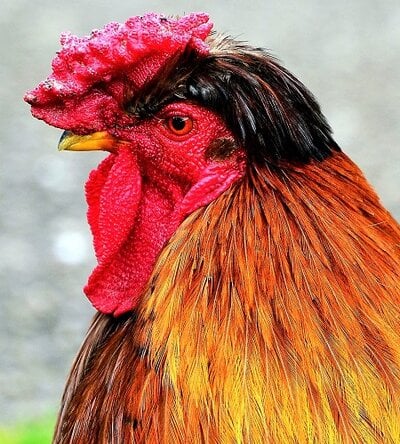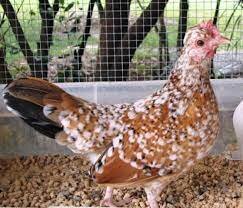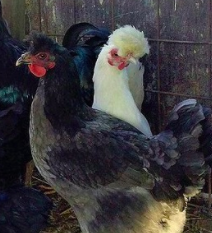Hi! Here is the second part to the crested chicken breed guide. Enjoy reading!
Mapuche Chaco Argentine
Pronunciation: ma-PU-chay CHA-coh ar-jen-TEEN

Brown breasted Black Mapuche Chaco Argentine hen
Alternate names: None
Egg color: Blue or green
Egg size or weight: Unknown
Eggs per year: Unknown
Purpose: Eggs
Weight: Roosters around 4.4 pounds, hens around 3.3 pounds
Disposition and temperament: Mapuche Chaco Argentines are good free-range birds
Description and facts: Mapuche Chaco Argentines are either red breasted black or brown breasted black. They have blue legs and red earlobes. They have medium-sized red single combs and wattles, and they have small tassel crests. The roosters’ crests are spiky
Place of origin: Argentina
History: History is unclear
Mapuche Huastec
Pronunciation: ma-PU-chay WHAS-tec

Black Mapuche Huastec hen

Black and Red Mapuche Huastec rooster
Alternate names: Mexican Silkie, Mexican Taihe, Mapuche Ona
Egg color: White, cream, blue, green, or brown
Egg size or weight: Unknown
Eggs per year: Unknown
Purpose: Eggs
Weight: Roosters around 5.5 pounds, hens around 4.4 pounds
Disposition and temperament: Mapuche Huastecs are good free-range birds
Description and facts: Mapuche Huastecs can be black, black partridge, black and red, or black laced gold. They have black or blackish-yellow legs, and some roosters have 5 toes. They have small combs that can be cushion, pea, single, strawberry, or walnut, and they have little to no wattles. Mapuche Huastecs have medium-sized tassel crests, and they can have red or white earlobes
Place of origin: Mexico and Ecuador
History: History is unclear
Mapuche Kiri Kiri
Pronunciation: ma-PU-chay KEE-re KEE-re

Duckwing Mapuche Kiri Kiri rooster(front) and hen(back)
Alternate names: Mapuche Paco, Mapuche Ona, Rapanui fowl
Egg color: Blue or green
Egg size or weight: Unknown
Eggs per year: Unknown
Purpose: Eggs
Weight: Roosters around 3.3 pounds, hens around 2.2 pounds
Disposition and temperament: Mapuche Kiri Kiris are good free-range birds and heat tolerant
Description and facts: Mapuche Kiri Kiris are either duckwing or black. They have blue legs and white earlobes, and some have beards. They have small red rose combs and wattles
Place of origin: Easter Island and Chile
History: Mapuche Kiri Kiris were thought to have been made by an ancestor being bred in the Easter Islands and being crossed by jungle fowl in Chile
Mapuche Nikkei
Pronunciation: ma-PU-chay nee-KAY

White Mapuche Nikkei rooster
Alternate names: None
Egg color: White or cream
Egg size or weight: Unknown
Eggs per year: Unknown
Purpose: Eggs
Weight: Roosters around 5.5 pounds, hens around 4.4 pounds
Disposition and temperament: Mapuche Nikkeis are good free-range birds
Description and facts: Mapuche Nikkeis are white with black or blackish-yellow legs. They have medium-sized red combs that can be cushion, pea, single, strawberry, or walnut. Their wattles are large and red, and they have tassel crests. Roosters’ crests are spiky
Place of origin: Mexico and Ecuador
History: History is unclear
Merlerault
Pronunciation: MARE-luh-row

Merlerault hen(front)

Merlerault rooster
Alternate names: None
Egg color: White or cream
Egg size or weight: Unknown
Eggs per year: Unknown
Purpose: Dual(eggs and meat)
Weight: Roosters around 6.6-7 pounds, hens around 5.5-6 pounds
Disposition and temperament: Merleraults are sweet and calm. They rarely go broody
Description and facts: Merleraults are black, but develop white feathers as they age. They have slate legs, and they have large red wattles and medium-sized v-shaped combs. Hens have medium-sized rounded crests, and roosters have medium-sized spiky tassel crests
Place of origin: Normandy, France
History: Merleraults are closely related to Crèvecœurs and Caumonts
Padovana
Pronunciation: PA-doh-VAH-nuh

White Padovana hen

Cuckoo Padovana rooster
Alternate names: Paduan
Egg color: White or cream
Egg size or weight: Small
Eggs per year: 120-150
Purpose: Dual (eggs and meat) and ornamental
Weight: Roosters around 4-5 pounds, hens around 3.3-4.4 pounds
Disposition and temperament: Padovanas are skittish but super sweet and docile. They don’t tend to go broody, and they tolerate confinement well
Description and facts: Padovanas can be black, blue, buff laced, cuckoo, gold laced, silver laced, sparrowhawk, or white. They have blue legs. They have no combs and little to no red wattles, which are often hidden by their beards. Hens have large and rounded crests, and roosters have large, rounded, and spiky crests
Place of origin: Padua, Italy
History: Padovanas have been around since the late 1300s. They are related to Polish, though it is unclear how
Pavlovskaya
Pronunciation: POV-lov-SKAY-uh

White Pavlovskaya hen from @ShannonsChimkens


Gold Spangled Pavlovskaya rooster from @ShannonsChimkens
Alternate names: Pavlov Crested, Russian Pavlov
Egg color: White or cream
Egg size or weight: 1.8 ounces
Eggs per year: 70-170
Purpose: Dual (eggs and meat) and ornamental
Weight: Roosters around 3.7-4 pounds, hens around 2.6-3 pounds
Disposition and temperament: Pavlovskayas are sweet and friendly, and love being active and free-ranging. As a result, they don’t tolerate confinement well. They are also very cold hardy
Description and facts: Pavlovskayas can be black, black-and-red spangled, brown, gold spangled, silver spangled, or wheaten. They have medium-sized red wattles and v-shaped combs, and muffs and beards. They have slate legs with unique, thick leg feathering like that of a grouse. A Russian myth says that Pavlovskayas were the illicit child of a chicken and a grouse. Hens have medium-sized upright full crests, and roosters have medium-sized upright spiky crests
Place of origin: Pavlovo, Russia
History: Pavlovskayas are the oldest Russian chicken breed, from the mid-1700s. Rumor has it that they came from the backyard of Catherine II, who was a Russian empress.
Polish
Pronunciation: POLE-ish

Silver Laced Polish hen and Gold Laced Polish hen from @Alohacayo

Bearded Buff Laced Polish rooster from @Fluffy Lambs

Bearded White Polish rooster from @Egg Snatcher

Black and White Crested Polish rooster from @Egg Snatcher

Black and White Crested Polish hen from @JustBabyMargo
Alternate names: Poland, Tophats
Egg color: White or cream
Egg size or weight: Medium
Eggs per year: 150-200
Purpose: Eggs and ornamental
Weight: Roosters around 6 pounds, hens around 4.4-4.5 pounds
Disposition and temperament: Polish are super friendly, docile, sweet, curious, and calm. They are kid-friendly and easy to handle. They are also flighty, and tend to be at the bottom of the pecking order. They like free-ranging but also do well in confinement
Description and facts: Polish come in many different color varieties, including bearded golden, bearded silver, bearded buff laced, black, black laced silver, black laced gold, non-bearded white crested black, non-bearded white crested blue, non-bearded buff laced, white, tolbunt, and many more. They have medium-sized red wattles and small red v-shaped combs. Polish have slate legs, and they can be bearded or frizzled. The hens have large and rounded upright crests, and the roosters have large and spiky crests
Place of origin: Netherlands
History: Polish have an unclear history. Their ancestors are thought to have been brought from Spain to Holland, and been bred by the Dutch into the breed they are today. They were likely bred in the 1700s
Polverara
Pronunciation: POL-ve-RAH-ruh

White Polverara hen

Black Polverara rooster
Alternate names: Schiatta, S’ciata
Egg color: White or cream
Egg size or weight: Medium
Eggs per year: 150
Purpose: Dual (eggs and meat)
Weight: Roosters around 5.5-6.2 pounds, hens around 4-4.6 pounds
Disposition and temperament: Polveraras are sweet, calm, and easy to handle. They love free-ranging and they don’t do well in confinement
Description and facts: Polveraras can be black with slate legs or white with willow legs. They have small red wattles and v-shaped combs, and muffs and beards. Hens have medium-sized upright full crests, and roosters have medium-sized upright spiky crests
Place of origin: Padua, Italy
History: Polveraras have been around since the 1400s. They are related to Padovanas
Posavina
Pronunciation: POH-suh-VEE-nuh

Partridge Posavina hens

Barred Posavina rooster
Alternate names: Posavska kukmasta kokoš
Egg color: Light brown
Egg size or weight: 2.1 ounces
Eggs per year: 160
Purpose: Dual (eggs and meat)
Weight: Roosters around 7.5-10 pounds, hens around 4.9-7.7 pounds
Disposition and temperament: Posavinas tend to go broody and make great mothers. They are known for being gentle breeds and are great foragers
Description and facts: Posavinas have many color varieties, the most common of which are barred, black-mottled, buff, partridge, silver-penciled, and white. They have medium-sized red wattles and single combs, and they have yellow legs. Hens have medium-sized full rounded crests or tassel crests, and roosters have small tassel crests
Place of origin: Posavina, Croatia
History: Posavinas were bred recently, in the early 2000s, by Zdravko Kozić and Josipa Bertinovca
Pyncheon
Pronunciation: PIN-chin

Mille Fleur Pyncheon hen

Mille Fleur Pyncheon rooster
Alternate names: None
Egg color: White or cream
Egg size or weight: Small
Eggs per year: Unknown
Purpose: Ornamental
Weight: Roosters around 1.5 pounds, hens around 1.4 pounds
Disposition and temperament: Pynchoens are very friendly, calm, quiet, and easily handled. They also go broody often, and do well in confinement
Description and facts: Pyncheons are mille fleur patterned or porcelain, with pink legs. They have medium-sized red wattles and single combs. They have tassel crests
Place of origin: Northeastern United States
History: Pyncheon’s ancestors were thought to have been brought from Belgium or the Netherlands
Rashin Rasha
Pronunciation: RASH-in RASH-uh

Partridge Rashin Rasha hen
Alternate names: None
Egg color: White or cream
Egg size or weight: Unknown
Eggs per year: Unknown
Purpose: Dual (eggs and meat)
Weight: Roosters around 7.7 pounds, hens around 4.4 pounds
Disposition and temperament: Rashin Rasha are very cold tolerant, and they are good free-range birds
Description and facts: Rashin Rasha have many color varieties, including black, blue, buff, brown, cuckoo, partridge, silver and black, and white. They have large red single combs and medium-sized red wattles. Their legs are yellow or willow and they have red earlobes. They have medium-sized full and rounded crests
Place of origin: Russia
History: History is unclear
Sanjak Longcrower
Pronunciation: SAN-jack LONG-crow-er

Blue Sanjak Longcrower hen(front) and White Sanjak Longcrower hen(back)

Black-and-white mottled Sanjak Longcrower rooster
Alternate names: Rogaš
Egg color: White or cream
Egg size or weight: 2.1-2.3 ounces
Eggs per year: 170
Purpose: Dual (eggs and meat) and crowing
Weight: Roosters around 8.8-11 pounds, hens around 5.5-6.6 pounds
Disposition and temperament: Sanjak Longcrowers are great free-range birds, and don’t like confinement. They rarely go broody, and are sweet, calm, and cold hardy
Description and facts: Sanjak Longcrowers can be black, black-and-white mottled, blue, red-shouldered black, or white, and they have willow legs. They have large red wattles and small red v-shaped combs. Hens have medium-sized rounded upright crests that fall forward slightly, and roosters have medium-sized spiky upright crests. The main difference between Sanjak Longcrowers and Kosovo Longcrowers is that Sanjak Longcrowers are larger and they have different color varieties
Place of origin: Sanjak, which is between Bosnia, Kosovo, and Serbia
History: Sanjak Longcrowers are closely related to Kosovo Longcrowers
Shetland Chicken
Pronunciation: SHET-land CHI-kin

Shetland hen up close

Shetland hen

Shetland rooster

Shetland rooster
Alternate names: Tappit Shetland
Egg color: Blue or green
Egg size or weight: Medium
Eggs per year: 150-200
Purpose: Dual (eggs and meat)
Weight: Unknown. They are small fowls
Disposition and temperament: Shetland chickens are calm, gentle, sweet, and easy to handle. They are also very hardy and good free-range birds. They also have a long laying season
Description facts: Shetland chickens are a landrace breed, so they all have different feathering, comb types, and leg color. Hens have medium-sized full rounded crests, and roosters have spiky tassel crests. Their other name, Tappit, means tuft in Scottish because of their crests shape
Place of origin: Scotland
History: Shetland chickens' ancestors were likely brought from Chile and Peru to Scotland by Spanish Galleons around the 1500s
Siberian Chicken
Pronunciation: si-BEER-ee-un CHI-kin

Siberian hen

Siberian rooster
Alternate names: None
Egg color: White or cream
Egg size or weight: 1.9-2.1 ounces
Eggs per year: 150-180
Purpose: Dual (eggs and meat)
Weight: Roosters around 6 pounds, hens around 4 pounds
Disposition and temperament: Siberian chickens tend to go broody and are great mothers. They are sweet, calm, and friendly
Description and facts: Siberian chickens have iridescent black plumage with feathered legs. They have small red v-shaped combs and wattles. They also have muffs and beards. Hens have medium-sized upright rounded crests, and roosters have medium-sized spiky crests
Place of origin: Russia
History: Siberian chickens were recorded in the 1800s, although they have likely been around since the 1600s
Silkie
Pronunciation: SILL-kee

Partridge Silkie rooster from @ForTheLoveOfSilkies

White Silkie hen with Silkie babies from @Fluffy Lambs

Blue Silkie hen from @Fluffy Lambs

Paint Silkie hen from @EricaSnow

White Silkie rooster from @All4Eggz
Alternate names: Chinese Silked Chicken, Silky
Egg color: White or cream
Egg size or weight: Small
Eggs per year: 100-120
Purpose: Dual (eggs and meat) and ornamental
Weight: Roosters around 2-3 pounds, hens around 1.5-2 pounds
Disposition and temperament: Silkies go broody a lot, and are great mothers. They are sweet, docile, quiet, calm, and kid-friendly. They are also easy to handle, confinement tolerant, and cold hardy
Description and facts: Silkies can be black, blue, buff, cuckoo, gold, grey, partridge and red. They have medium-sized red or purple wattles and walnut combs. They have feathered slate legs, 5 toes, and muffs and beards. Silkies can have small, rounded, puffy crests or upright crests that fall forwards
Place of origin: Asia
History: It is unclear where and when Silkies came from. They have been around since the 1200s. They are thought to have come from China, India, or Japan
Sombor Crested
Pronunciation: SOM-bore CRESS-ted

Wheaten Sombor Crested hen

Wheaten Sombor Crested rooster
Alternate names: Somborska Kaporka
Egg color: White or cream
Egg size or weight:
Eggs per year: 200-260
Purpose: Dual (eggs and meat)
Weight: Roosters around 7.7-8.8 pounds, hens around 5.5-6.6 pounds
Disposition and temperament: Sombor Cresteds are good free-range birds, good broodies, and good winter layers. They are also cold hardy
Description and facts: Sombor Cresteds can be barred, black, blue, brown, buff, wheaten, or white. They have large red wattles and single combs, and they have willow legs. Hens have large, full, rounded, and upright crests, and roosters have large crests that sweep back
Place of origin: Vojvodina, Serbia
History: Sombor Cresteds were bred in the early 1900s by crossing local chickens with Houdans and Sulmtalers
Sulmtaler
Pronunciation: SULM-tah-ler

Wheaten Sulmtaler hen

Wheaten Sulmtaler rooster
Alternate names: None
Egg color: Light brown
Egg size or weight: Medium
Eggs per year: 130-200
Purpose: Dual (eggs and meat)
Weight: Roosters around 6.6-8.8 pounds, hens around 5.5-7.7 pounds
Disposition and temperament: Sulmtalers are very hardy, and do well in all environments. They are good free-range birds, and don’t do well in confinement. They are also calm and friendly, and good flyers
Description and facts: Sulmtalers can be blue wheaten, gold duckwing, gold wheaten, silver wheaten, or white. They have medium-sized red wattles and single combs. They have medium-sized tassel crests and light pink legs
Place of origin: Sulm Valley, Austria
History: Sulmtalers have been around since the 1400s
Struma
Pronunciation: STROO-muh

Brown-and-white mottled Struma hen

Black-and-white mottled Struma rooster
Alternate names: None
Egg color: Light brown
Egg size or weight: 1.8-1.9 ounces
Eggs per year: 150-180
Purpose: Dual (eggs and meat)
Weight: Roosters around 7-8.4 pounds, hens around 6.2-7 pounds
Disposition and temperament: Strumas are good free-range birds and aren’t confinement tolerant. They are also sweet and calm
Description and facts: Strumas can be white-and-black mottled or brown-and-white mottled. They have small red wattles and large red buttercup combs. They have yellow feathered legs, and muffs and beards. Hens have large, rounded, full crests, and roosters have large crests that sweep back
Place of origin: Bulgaria
History: History is unclear
Sultan
Pronunciation: SULL-tun

White Sultan hen

White Sultan rooster from @Jenessa_096
Alternate names: Serai-Tavuk
Egg color: White or cream
Egg size or weight: Small
Eggs per year: 50-60
Purpose: Ornamental
Weight: Roosters around 6 pounds, hens around 4 pounds
Disposition and temperament: Sultans are very sweet, calm, kid-friendly, and docile. They tend to be at the bottom of the pecking order, and do well in confinement. They aren’t good free-range birds
Description and facts: Sultans can be black, blue, or white. They have small red wattles and v-shaped combs, and they have muffs, beards, and slate feathered legs with 5 toes. Hens have medium-sized, rounded, and puffy crests, and roosters have medium-sized tassel crests
Place of origin: Turkey
History: Sultan chickens were kept by Sultans in Turkey many centuries ago. It is unclear when they were first bred
Swedish Flower Crested
Pronunciation: SWEE-dish FLOW-er CRESS-ted

Swedish Flower Crested hen from @ShannonsChimkens

Swedish Flower Crested rooster from @ShannonsChimkens
Alternate names: None
Egg color: White or cream
Egg size or weight: Large
Eggs per year: 150-200
Purpose: Dual (eggs and meat)
Weight: Roosters around 7.7 pounds, hens around 5.5 pounds
Disposition and temperament: Swedish Flower Cresteds are sweet, docile, and calm. They are also cold hardy
Description and facts: Swedish Flower Cresteds are mottled (black, buff, red, or white) with yellow legs. They have large red wattles and single combs. Hens have medium-sized full crests that sweep back, and roosters have spiky tassel crests
Place of origin: Sweden
History: Swedish Flower Cresteds most likely were bred from wild chickens brought to Sweden by settlers
Turopolske
Pronunciation: TUR-oh-pole-sk

Turopolske rooster
Alternate names: Croatian Dwarf Chicken, Jurek, Katica
Egg color: White or cream
Egg size or weight: Unknown
Eggs per year: Unknown
Purpose: Dual (eggs and meat)
Weight: Roosters around 7.7 pounds, hens around 5.5 pounds
Disposition and temperament: Turopolskes are calm, sweet, and cold hardy. They are good free-range birds and don’t do well in confinement
Description and facts: Turopolske are duckwing. They have medium-sized red wattles and single combs, and yellow legs. Hens have medium-sized full rounded crests, and roosters have medium-sized tassel crests
Place of origin: Croatia
History: History is unclear
Ukrainian Crested
Pronunciation: yoo-CRAY-nee-un CRESS-ted

Cuckoo Ukrainian Crested hen

Black-breasted-red Ukrainian Crested rooster
Alternate names: Chubaty
Egg color: White or cream
Egg size or weight: 1.9
Eggs per year: 150-180
Purpose: Dual (eggs and meat)
Weight: Roosters around 6.2-7 pounds, hens around 4.9-5.5 pounds
Disposition and temperament: Ukrainian Cresteds start laying around 6 months of age. They tend to go broody and make good mothers. They also are very cold hardy
Description and facts: Ukrainian Cresteds come in colombian, cuckoo, black, black-breasted-red, brown, or buff. They have medium-sized combs, which can be rose or single. Their legs are yellow, and they have red earlobes and small red wattles. A rooster’s crest is a medium-sized tassel crest, and a hen’s crest is large, upright, and rounded
Place of origin: Ukraine
History: History is unclear
Vincan Horned Fowl
Pronunciation: VIN-cun horned FOW-l

White Vincan Horned Fowl rooster
Alternate names: Vincanski Jelenak, Vinča Jelenak
Egg color: White or cream
Egg size or weight: 1.8-1.9 ounces
Eggs per year: 100-120
Purpose: Dual (eggs and meat) and ornamental
Weight: Roosters around 6.6 pounds, hens around 4.4 pounds
Disposition and temperament: Vincan Horned Fowls are friendly, calm, and alert. They are great free-range birds, and don’t like confinement
Description and facts: Vincan Horned Fowls are white. They have large red wattles and v-shaped combs, and they have yellow legs. They have medium-sized tassel crests. They are named Vinča Jelenak because Vinča is the place they were bred, and Jelenak means stag beetle, which is what their large combs look like
Place of origin: Vinca, Serbia
History: Vincan Horned Fowls were bred recently, in the ‘90s. They were bred by Aleksandar Kuga by crossing Polish, La Flêche, and Sombor Cresteds
Thank you so much for reading my article! I'd love it if you could leave a rating or feedback. Hope you learned something new!
Mapuche Chaco Argentine
Pronunciation: ma-PU-chay CHA-coh ar-jen-TEEN
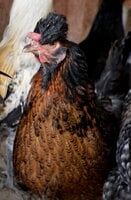
Brown breasted Black Mapuche Chaco Argentine hen
Alternate names: None
Egg color: Blue or green
Egg size or weight: Unknown
Eggs per year: Unknown
Purpose: Eggs
Weight: Roosters around 4.4 pounds, hens around 3.3 pounds
Disposition and temperament: Mapuche Chaco Argentines are good free-range birds
Description and facts: Mapuche Chaco Argentines are either red breasted black or brown breasted black. They have blue legs and red earlobes. They have medium-sized red single combs and wattles, and they have small tassel crests. The roosters’ crests are spiky
Place of origin: Argentina
History: History is unclear
Mapuche Huastec
Pronunciation: ma-PU-chay WHAS-tec
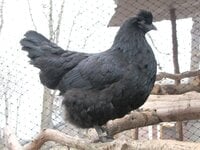
Black Mapuche Huastec hen
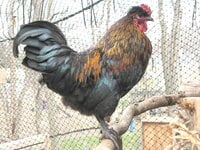
Black and Red Mapuche Huastec rooster
Alternate names: Mexican Silkie, Mexican Taihe, Mapuche Ona
Egg color: White, cream, blue, green, or brown
Egg size or weight: Unknown
Eggs per year: Unknown
Purpose: Eggs
Weight: Roosters around 5.5 pounds, hens around 4.4 pounds
Disposition and temperament: Mapuche Huastecs are good free-range birds
Description and facts: Mapuche Huastecs can be black, black partridge, black and red, or black laced gold. They have black or blackish-yellow legs, and some roosters have 5 toes. They have small combs that can be cushion, pea, single, strawberry, or walnut, and they have little to no wattles. Mapuche Huastecs have medium-sized tassel crests, and they can have red or white earlobes
Place of origin: Mexico and Ecuador
History: History is unclear
Mapuche Kiri Kiri
Pronunciation: ma-PU-chay KEE-re KEE-re
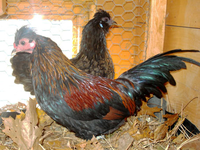
Duckwing Mapuche Kiri Kiri rooster(front) and hen(back)
Alternate names: Mapuche Paco, Mapuche Ona, Rapanui fowl
Egg color: Blue or green
Egg size or weight: Unknown
Eggs per year: Unknown
Purpose: Eggs
Weight: Roosters around 3.3 pounds, hens around 2.2 pounds
Disposition and temperament: Mapuche Kiri Kiris are good free-range birds and heat tolerant
Description and facts: Mapuche Kiri Kiris are either duckwing or black. They have blue legs and white earlobes, and some have beards. They have small red rose combs and wattles
Place of origin: Easter Island and Chile
History: Mapuche Kiri Kiris were thought to have been made by an ancestor being bred in the Easter Islands and being crossed by jungle fowl in Chile
Mapuche Nikkei
Pronunciation: ma-PU-chay nee-KAY

White Mapuche Nikkei rooster
Alternate names: None
Egg color: White or cream
Egg size or weight: Unknown
Eggs per year: Unknown
Purpose: Eggs
Weight: Roosters around 5.5 pounds, hens around 4.4 pounds
Disposition and temperament: Mapuche Nikkeis are good free-range birds
Description and facts: Mapuche Nikkeis are white with black or blackish-yellow legs. They have medium-sized red combs that can be cushion, pea, single, strawberry, or walnut. Their wattles are large and red, and they have tassel crests. Roosters’ crests are spiky
Place of origin: Mexico and Ecuador
History: History is unclear
Merlerault
Pronunciation: MARE-luh-row
Merlerault hen(front)
Merlerault rooster
Alternate names: None
Egg color: White or cream
Egg size or weight: Unknown
Eggs per year: Unknown
Purpose: Dual(eggs and meat)
Weight: Roosters around 6.6-7 pounds, hens around 5.5-6 pounds
Disposition and temperament: Merleraults are sweet and calm. They rarely go broody
Description and facts: Merleraults are black, but develop white feathers as they age. They have slate legs, and they have large red wattles and medium-sized v-shaped combs. Hens have medium-sized rounded crests, and roosters have medium-sized spiky tassel crests
Place of origin: Normandy, France
History: Merleraults are closely related to Crèvecœurs and Caumonts
Padovana
Pronunciation: PA-doh-VAH-nuh
White Padovana hen
Cuckoo Padovana rooster
Alternate names: Paduan
Egg color: White or cream
Egg size or weight: Small
Eggs per year: 120-150
Purpose: Dual (eggs and meat) and ornamental
Weight: Roosters around 4-5 pounds, hens around 3.3-4.4 pounds
Disposition and temperament: Padovanas are skittish but super sweet and docile. They don’t tend to go broody, and they tolerate confinement well
Description and facts: Padovanas can be black, blue, buff laced, cuckoo, gold laced, silver laced, sparrowhawk, or white. They have blue legs. They have no combs and little to no red wattles, which are often hidden by their beards. Hens have large and rounded crests, and roosters have large, rounded, and spiky crests
Place of origin: Padua, Italy
History: Padovanas have been around since the late 1300s. They are related to Polish, though it is unclear how
Pavlovskaya
Pronunciation: POV-lov-SKAY-uh
White Pavlovskaya hen from @ShannonsChimkens
Gold Spangled Pavlovskaya rooster from @ShannonsChimkens
Alternate names: Pavlov Crested, Russian Pavlov
Egg color: White or cream
Egg size or weight: 1.8 ounces
Eggs per year: 70-170
Purpose: Dual (eggs and meat) and ornamental
Weight: Roosters around 3.7-4 pounds, hens around 2.6-3 pounds
Disposition and temperament: Pavlovskayas are sweet and friendly, and love being active and free-ranging. As a result, they don’t tolerate confinement well. They are also very cold hardy
Description and facts: Pavlovskayas can be black, black-and-red spangled, brown, gold spangled, silver spangled, or wheaten. They have medium-sized red wattles and v-shaped combs, and muffs and beards. They have slate legs with unique, thick leg feathering like that of a grouse. A Russian myth says that Pavlovskayas were the illicit child of a chicken and a grouse. Hens have medium-sized upright full crests, and roosters have medium-sized upright spiky crests
Place of origin: Pavlovo, Russia
History: Pavlovskayas are the oldest Russian chicken breed, from the mid-1700s. Rumor has it that they came from the backyard of Catherine II, who was a Russian empress.
Polish
Pronunciation: POLE-ish
Silver Laced Polish hen and Gold Laced Polish hen from @Alohacayo
Bearded Buff Laced Polish rooster from @Fluffy Lambs
Bearded White Polish rooster from @Egg Snatcher
Black and White Crested Polish rooster from @Egg Snatcher
Black and White Crested Polish hen from @JustBabyMargo
Alternate names: Poland, Tophats
Egg color: White or cream
Egg size or weight: Medium
Eggs per year: 150-200
Purpose: Eggs and ornamental
Weight: Roosters around 6 pounds, hens around 4.4-4.5 pounds
Disposition and temperament: Polish are super friendly, docile, sweet, curious, and calm. They are kid-friendly and easy to handle. They are also flighty, and tend to be at the bottom of the pecking order. They like free-ranging but also do well in confinement
Description and facts: Polish come in many different color varieties, including bearded golden, bearded silver, bearded buff laced, black, black laced silver, black laced gold, non-bearded white crested black, non-bearded white crested blue, non-bearded buff laced, white, tolbunt, and many more. They have medium-sized red wattles and small red v-shaped combs. Polish have slate legs, and they can be bearded or frizzled. The hens have large and rounded upright crests, and the roosters have large and spiky crests
Place of origin: Netherlands
History: Polish have an unclear history. Their ancestors are thought to have been brought from Spain to Holland, and been bred by the Dutch into the breed they are today. They were likely bred in the 1700s
Polverara
Pronunciation: POL-ve-RAH-ruh
White Polverara hen
Black Polverara rooster
Alternate names: Schiatta, S’ciata
Egg color: White or cream
Egg size or weight: Medium
Eggs per year: 150
Purpose: Dual (eggs and meat)
Weight: Roosters around 5.5-6.2 pounds, hens around 4-4.6 pounds
Disposition and temperament: Polveraras are sweet, calm, and easy to handle. They love free-ranging and they don’t do well in confinement
Description and facts: Polveraras can be black with slate legs or white with willow legs. They have small red wattles and v-shaped combs, and muffs and beards. Hens have medium-sized upright full crests, and roosters have medium-sized upright spiky crests
Place of origin: Padua, Italy
History: Polveraras have been around since the 1400s. They are related to Padovanas
Posavina
Pronunciation: POH-suh-VEE-nuh
Partridge Posavina hens
Barred Posavina rooster
Alternate names: Posavska kukmasta kokoš
Egg color: Light brown
Egg size or weight: 2.1 ounces
Eggs per year: 160
Purpose: Dual (eggs and meat)
Weight: Roosters around 7.5-10 pounds, hens around 4.9-7.7 pounds
Disposition and temperament: Posavinas tend to go broody and make great mothers. They are known for being gentle breeds and are great foragers
Description and facts: Posavinas have many color varieties, the most common of which are barred, black-mottled, buff, partridge, silver-penciled, and white. They have medium-sized red wattles and single combs, and they have yellow legs. Hens have medium-sized full rounded crests or tassel crests, and roosters have small tassel crests
Place of origin: Posavina, Croatia
History: Posavinas were bred recently, in the early 2000s, by Zdravko Kozić and Josipa Bertinovca
Pyncheon
Pronunciation: PIN-chin
Mille Fleur Pyncheon hen
Mille Fleur Pyncheon rooster
Alternate names: None
Egg color: White or cream
Egg size or weight: Small
Eggs per year: Unknown
Purpose: Ornamental
Weight: Roosters around 1.5 pounds, hens around 1.4 pounds
Disposition and temperament: Pynchoens are very friendly, calm, quiet, and easily handled. They also go broody often, and do well in confinement
Description and facts: Pyncheons are mille fleur patterned or porcelain, with pink legs. They have medium-sized red wattles and single combs. They have tassel crests
Place of origin: Northeastern United States
History: Pyncheon’s ancestors were thought to have been brought from Belgium or the Netherlands
Rashin Rasha
Pronunciation: RASH-in RASH-uh
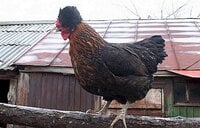
Partridge Rashin Rasha hen
Alternate names: None
Egg color: White or cream
Egg size or weight: Unknown
Eggs per year: Unknown
Purpose: Dual (eggs and meat)
Weight: Roosters around 7.7 pounds, hens around 4.4 pounds
Disposition and temperament: Rashin Rasha are very cold tolerant, and they are good free-range birds
Description and facts: Rashin Rasha have many color varieties, including black, blue, buff, brown, cuckoo, partridge, silver and black, and white. They have large red single combs and medium-sized red wattles. Their legs are yellow or willow and they have red earlobes. They have medium-sized full and rounded crests
Place of origin: Russia
History: History is unclear
Sanjak Longcrower
Pronunciation: SAN-jack LONG-crow-er
Blue Sanjak Longcrower hen(front) and White Sanjak Longcrower hen(back)
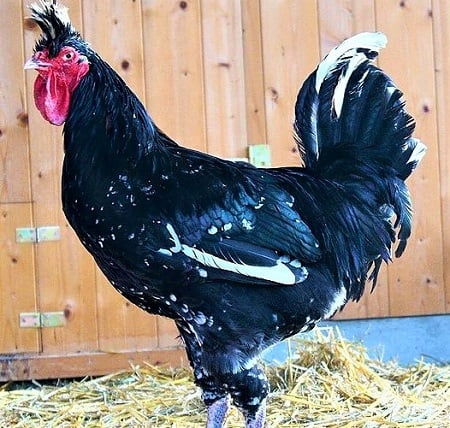
Black-and-white mottled Sanjak Longcrower rooster
Alternate names: Rogaš
Egg color: White or cream
Egg size or weight: 2.1-2.3 ounces
Eggs per year: 170
Purpose: Dual (eggs and meat) and crowing
Weight: Roosters around 8.8-11 pounds, hens around 5.5-6.6 pounds
Disposition and temperament: Sanjak Longcrowers are great free-range birds, and don’t like confinement. They rarely go broody, and are sweet, calm, and cold hardy
Description and facts: Sanjak Longcrowers can be black, black-and-white mottled, blue, red-shouldered black, or white, and they have willow legs. They have large red wattles and small red v-shaped combs. Hens have medium-sized rounded upright crests that fall forward slightly, and roosters have medium-sized spiky upright crests. The main difference between Sanjak Longcrowers and Kosovo Longcrowers is that Sanjak Longcrowers are larger and they have different color varieties
Place of origin: Sanjak, which is between Bosnia, Kosovo, and Serbia
History: Sanjak Longcrowers are closely related to Kosovo Longcrowers
Shetland Chicken
Pronunciation: SHET-land CHI-kin
Shetland hen up close
Shetland hen
Shetland rooster
Shetland rooster
Alternate names: Tappit Shetland
Egg color: Blue or green
Egg size or weight: Medium
Eggs per year: 150-200
Purpose: Dual (eggs and meat)
Weight: Unknown. They are small fowls
Disposition and temperament: Shetland chickens are calm, gentle, sweet, and easy to handle. They are also very hardy and good free-range birds. They also have a long laying season
Description facts: Shetland chickens are a landrace breed, so they all have different feathering, comb types, and leg color. Hens have medium-sized full rounded crests, and roosters have spiky tassel crests. Their other name, Tappit, means tuft in Scottish because of their crests shape
Place of origin: Scotland
History: Shetland chickens' ancestors were likely brought from Chile and Peru to Scotland by Spanish Galleons around the 1500s
Siberian Chicken
Pronunciation: si-BEER-ee-un CHI-kin
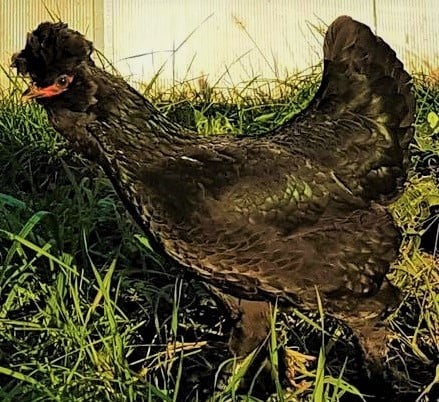
Siberian hen
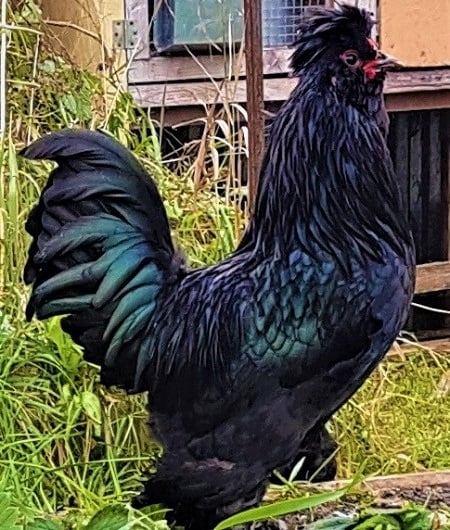
Siberian rooster
Alternate names: None
Egg color: White or cream
Egg size or weight: 1.9-2.1 ounces
Eggs per year: 150-180
Purpose: Dual (eggs and meat)
Weight: Roosters around 6 pounds, hens around 4 pounds
Disposition and temperament: Siberian chickens tend to go broody and are great mothers. They are sweet, calm, and friendly
Description and facts: Siberian chickens have iridescent black plumage with feathered legs. They have small red v-shaped combs and wattles. They also have muffs and beards. Hens have medium-sized upright rounded crests, and roosters have medium-sized spiky crests
Place of origin: Russia
History: Siberian chickens were recorded in the 1800s, although they have likely been around since the 1600s
Silkie
Pronunciation: SILL-kee
Partridge Silkie rooster from @ForTheLoveOfSilkies
White Silkie hen with Silkie babies from @Fluffy Lambs
Blue Silkie hen from @Fluffy Lambs
Paint Silkie hen from @EricaSnow
White Silkie rooster from @All4Eggz
Alternate names: Chinese Silked Chicken, Silky
Egg color: White or cream
Egg size or weight: Small
Eggs per year: 100-120
Purpose: Dual (eggs and meat) and ornamental
Weight: Roosters around 2-3 pounds, hens around 1.5-2 pounds
Disposition and temperament: Silkies go broody a lot, and are great mothers. They are sweet, docile, quiet, calm, and kid-friendly. They are also easy to handle, confinement tolerant, and cold hardy
Description and facts: Silkies can be black, blue, buff, cuckoo, gold, grey, partridge and red. They have medium-sized red or purple wattles and walnut combs. They have feathered slate legs, 5 toes, and muffs and beards. Silkies can have small, rounded, puffy crests or upright crests that fall forwards
Place of origin: Asia
History: It is unclear where and when Silkies came from. They have been around since the 1200s. They are thought to have come from China, India, or Japan
Sombor Crested
Pronunciation: SOM-bore CRESS-ted
Wheaten Sombor Crested hen
Wheaten Sombor Crested rooster
Alternate names: Somborska Kaporka
Egg color: White or cream
Egg size or weight:
Eggs per year: 200-260
Purpose: Dual (eggs and meat)
Weight: Roosters around 7.7-8.8 pounds, hens around 5.5-6.6 pounds
Disposition and temperament: Sombor Cresteds are good free-range birds, good broodies, and good winter layers. They are also cold hardy
Description and facts: Sombor Cresteds can be barred, black, blue, brown, buff, wheaten, or white. They have large red wattles and single combs, and they have willow legs. Hens have large, full, rounded, and upright crests, and roosters have large crests that sweep back
Place of origin: Vojvodina, Serbia
History: Sombor Cresteds were bred in the early 1900s by crossing local chickens with Houdans and Sulmtalers
Sulmtaler
Pronunciation: SULM-tah-ler
Wheaten Sulmtaler hen

Wheaten Sulmtaler rooster
Alternate names: None
Egg color: Light brown
Egg size or weight: Medium
Eggs per year: 130-200
Purpose: Dual (eggs and meat)
Weight: Roosters around 6.6-8.8 pounds, hens around 5.5-7.7 pounds
Disposition and temperament: Sulmtalers are very hardy, and do well in all environments. They are good free-range birds, and don’t do well in confinement. They are also calm and friendly, and good flyers
Description and facts: Sulmtalers can be blue wheaten, gold duckwing, gold wheaten, silver wheaten, or white. They have medium-sized red wattles and single combs. They have medium-sized tassel crests and light pink legs
Place of origin: Sulm Valley, Austria
History: Sulmtalers have been around since the 1400s
Struma
Pronunciation: STROO-muh
Brown-and-white mottled Struma hen
Black-and-white mottled Struma rooster
Alternate names: None
Egg color: Light brown
Egg size or weight: 1.8-1.9 ounces
Eggs per year: 150-180
Purpose: Dual (eggs and meat)
Weight: Roosters around 7-8.4 pounds, hens around 6.2-7 pounds
Disposition and temperament: Strumas are good free-range birds and aren’t confinement tolerant. They are also sweet and calm
Description and facts: Strumas can be white-and-black mottled or brown-and-white mottled. They have small red wattles and large red buttercup combs. They have yellow feathered legs, and muffs and beards. Hens have large, rounded, full crests, and roosters have large crests that sweep back
Place of origin: Bulgaria
History: History is unclear
Sultan
Pronunciation: SULL-tun
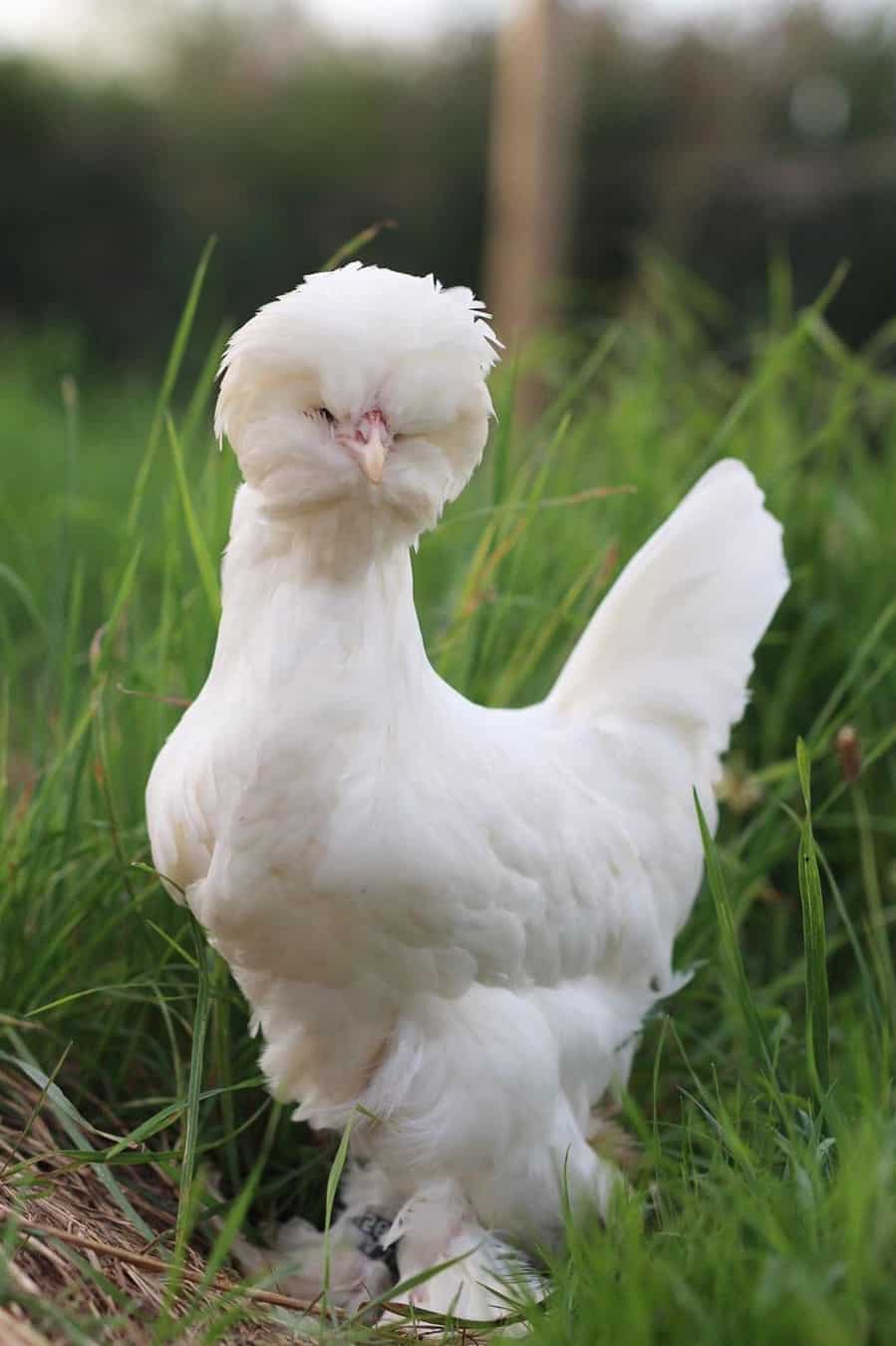
White Sultan hen
White Sultan rooster from @Jenessa_096
Alternate names: Serai-Tavuk
Egg color: White or cream
Egg size or weight: Small
Eggs per year: 50-60
Purpose: Ornamental
Weight: Roosters around 6 pounds, hens around 4 pounds
Disposition and temperament: Sultans are very sweet, calm, kid-friendly, and docile. They tend to be at the bottom of the pecking order, and do well in confinement. They aren’t good free-range birds
Description and facts: Sultans can be black, blue, or white. They have small red wattles and v-shaped combs, and they have muffs, beards, and slate feathered legs with 5 toes. Hens have medium-sized, rounded, and puffy crests, and roosters have medium-sized tassel crests
Place of origin: Turkey
History: Sultan chickens were kept by Sultans in Turkey many centuries ago. It is unclear when they were first bred
Swedish Flower Crested
Pronunciation: SWEE-dish FLOW-er CRESS-ted
Swedish Flower Crested hen from @ShannonsChimkens
Swedish Flower Crested rooster from @ShannonsChimkens
Alternate names: None
Egg color: White or cream
Egg size or weight: Large
Eggs per year: 150-200
Purpose: Dual (eggs and meat)
Weight: Roosters around 7.7 pounds, hens around 5.5 pounds
Disposition and temperament: Swedish Flower Cresteds are sweet, docile, and calm. They are also cold hardy
Description and facts: Swedish Flower Cresteds are mottled (black, buff, red, or white) with yellow legs. They have large red wattles and single combs. Hens have medium-sized full crests that sweep back, and roosters have spiky tassel crests
Place of origin: Sweden
History: Swedish Flower Cresteds most likely were bred from wild chickens brought to Sweden by settlers
Turopolske
Pronunciation: TUR-oh-pole-sk
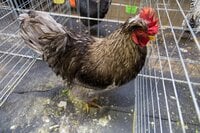
Turopolske rooster
Alternate names: Croatian Dwarf Chicken, Jurek, Katica
Egg color: White or cream
Egg size or weight: Unknown
Eggs per year: Unknown
Purpose: Dual (eggs and meat)
Weight: Roosters around 7.7 pounds, hens around 5.5 pounds
Disposition and temperament: Turopolskes are calm, sweet, and cold hardy. They are good free-range birds and don’t do well in confinement
Description and facts: Turopolske are duckwing. They have medium-sized red wattles and single combs, and yellow legs. Hens have medium-sized full rounded crests, and roosters have medium-sized tassel crests
Place of origin: Croatia
History: History is unclear
Ukrainian Crested
Pronunciation: yoo-CRAY-nee-un CRESS-ted
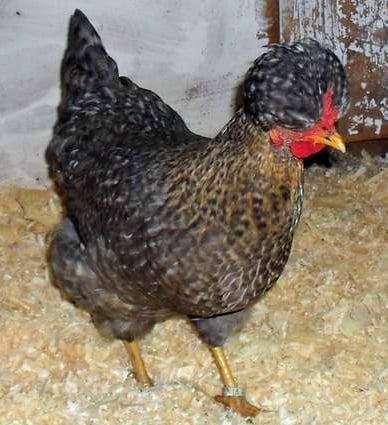
Cuckoo Ukrainian Crested hen

Black-breasted-red Ukrainian Crested rooster
Alternate names: Chubaty
Egg color: White or cream
Egg size or weight: 1.9
Eggs per year: 150-180
Purpose: Dual (eggs and meat)
Weight: Roosters around 6.2-7 pounds, hens around 4.9-5.5 pounds
Disposition and temperament: Ukrainian Cresteds start laying around 6 months of age. They tend to go broody and make good mothers. They also are very cold hardy
Description and facts: Ukrainian Cresteds come in colombian, cuckoo, black, black-breasted-red, brown, or buff. They have medium-sized combs, which can be rose or single. Their legs are yellow, and they have red earlobes and small red wattles. A rooster’s crest is a medium-sized tassel crest, and a hen’s crest is large, upright, and rounded
Place of origin: Ukraine
History: History is unclear
Vincan Horned Fowl
Pronunciation: VIN-cun horned FOW-l
White Vincan Horned Fowl rooster
Alternate names: Vincanski Jelenak, Vinča Jelenak
Egg color: White or cream
Egg size or weight: 1.8-1.9 ounces
Eggs per year: 100-120
Purpose: Dual (eggs and meat) and ornamental
Weight: Roosters around 6.6 pounds, hens around 4.4 pounds
Disposition and temperament: Vincan Horned Fowls are friendly, calm, and alert. They are great free-range birds, and don’t like confinement
Description and facts: Vincan Horned Fowls are white. They have large red wattles and v-shaped combs, and they have yellow legs. They have medium-sized tassel crests. They are named Vinča Jelenak because Vinča is the place they were bred, and Jelenak means stag beetle, which is what their large combs look like
Place of origin: Vinca, Serbia
History: Vincan Horned Fowls were bred recently, in the ‘90s. They were bred by Aleksandar Kuga by crossing Polish, La Flêche, and Sombor Cresteds
Thank you so much for reading my article! I'd love it if you could leave a rating or feedback. Hope you learned something new!

